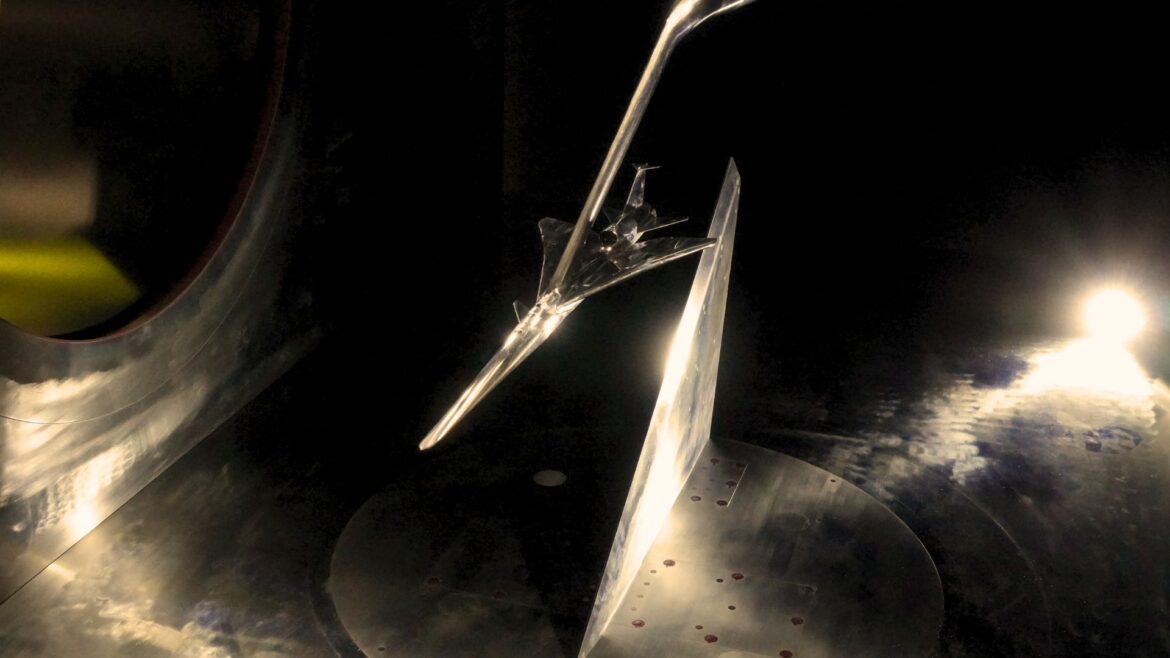Researchers from NASA and the Japanese Aerospace Exploration Agency (JAXA) have completed a fresh round of supersonic wind-tunnel testing on a miniature version of NASA’s X-59 quiet-supersonic experimental aircraft.
The campaign was conducted at JAXA’s 3-by-3-foot facility in Chofu, Tokyo. It assessed how the aircraft’s pressure signature, audible on the ground as a sonic “thump,” will reach people beneath its flight path.
Tiny model, full-scale stakes
The X-59 demonstrator measures 99.7 feet in length with a 29.7-foot wingspan, but the Chofu tunnel could only accommodate a model 19 inches nose-to-tail, just 1.62 percent of the real jet. Engineers nevertheless subjected the diminutive replica to airflow conditions representing the aircraft’s planned cruise of Mach 1.4, about 925 miles per hour.
By comparing the wind-tunnel data with detailed Computational Fluid Dynamics predictions, NASA can validate how air will wrap around the jet’s slender fuselage and long, highly swept wing, and, critically, how its shock waves are expected to behave.
Unlike conventional supersonic airplanes, whose shock waves combine into a single, ground-shaking blast, the X-59’s carefully sculpted nose and chine are intended to separate those waves. The goal is a brief, low-volume “sonic thump” rather than an ear-splitting boom, opening the door to overland supersonic passenger flight.
The Chofu tests mark the third time the model has entered a wind tunnel, following earlier runs at JAXA and NASA’s Glenn Research Center in Ohio, and they delivered “critical experimental data to compare to…predictions,” NASA noted.
Milestones on the road to first flight
The wind-tunnel campaign is only the latest checkpoint for the program. In December 2024, engineers completed the first full engine-burning test for the aircraft. Conducted on December 12 at Lockheed Martin’s Skunk Works facility in Palmdale, California, where the airplane was built. The run pushed the integrated propulsion system to full power for the first time.
It followed an October 2024 shakedown, when the engine was spun at low speeds mainly to sniff out leaks and other early-stage issues. Progress continued this spring. In May 2025, the team wrapped up a series of high-fidelity simulations that commanded the X-59’s flight computer and subsystems to behave exactly as they would thousands of feet above the Mojave Desert without ever leaving the ground.
That rehearsal confirmed that sensors, control surfaces, and redundant computers can talk to one another seamlessly during the high-altitude, high-speed mission profile the aircraft will eventually fly.
The X-59 is the centerpiece of NASA’s Quesst mission, an effort to prove that quiet supersonic flight is technically and socially viable. Once airborne, the jet will make a series of community overflights across the United States so researchers can gauge how residents react to its muted acoustic footprint.
Their feedback, combined with the aerodynamic and acoustic data now being amassed in wind tunnels and ground tests, will inform regulators as they consider lifting the decades-old ban on supersonic flight over land.
The 19-inch model that braved Mach-1.4 winds in Chofu takes us one step closer to turning the boom into a thump. Success could hand commercial aircraft designers a toolkit for shaping future airliners that dash across continents at supersonic speeds without rattling windows below.


AloJapan.com